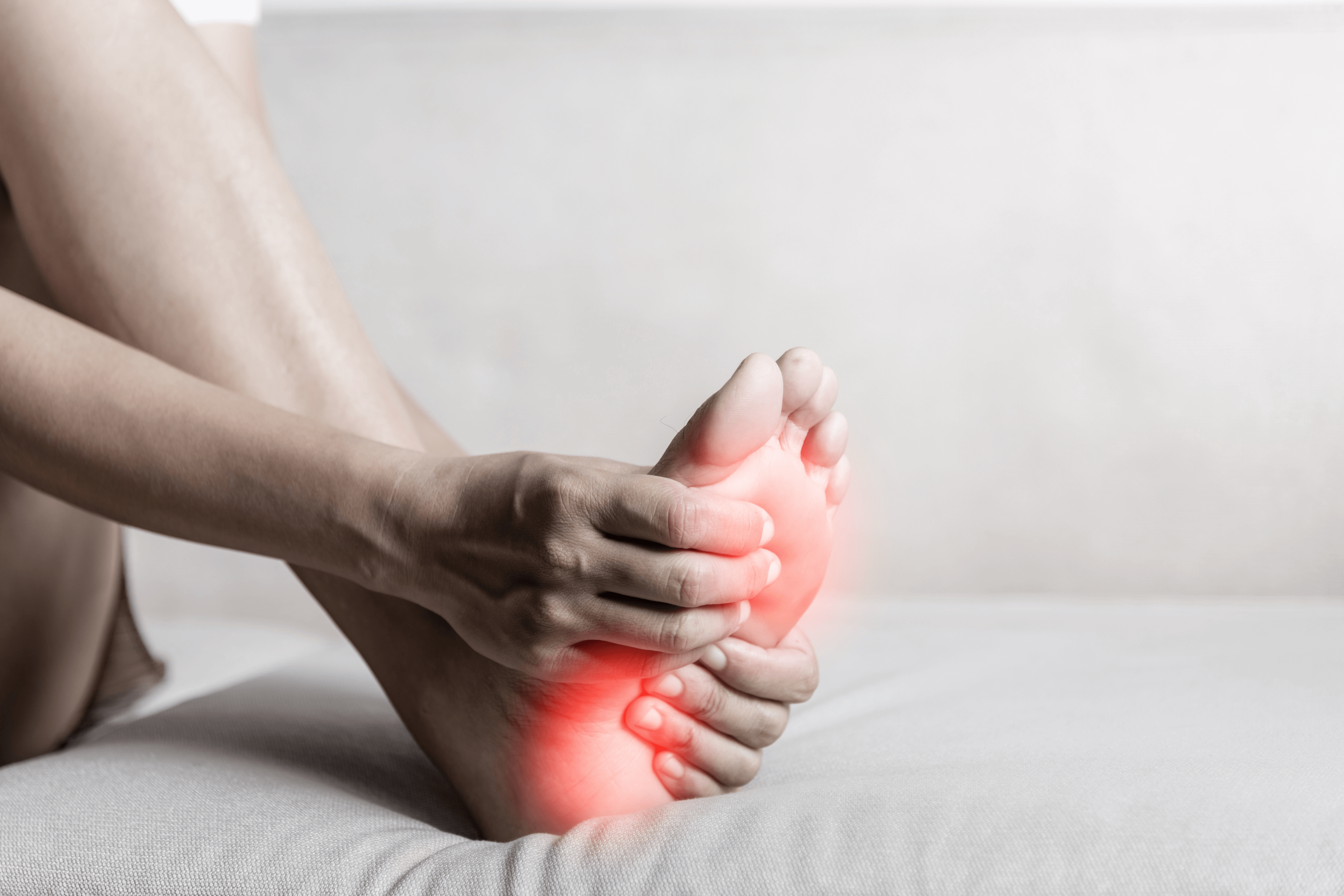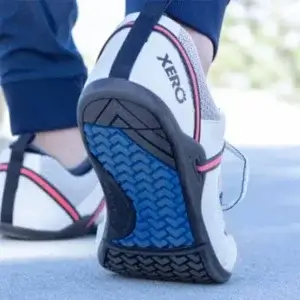Your feet are more than just the foundation of your body—they are the foundation of your life. Every step you take, whether it’s a casual stroll, a jog, or simply standing still, relies on the health and strength of your feet.
As we age, this connection becomes even more critical. Weak or improperly supported feet can lead to poor posture, throwing off the alignment of your knees, hips, and back. This can compromise your balance, increasing the risk of falls.
When it comes to your feet, improper care can also lead to conditions like plantar fasciitis, bunions, hammertoes, or flat feet, which often contribute to poor posture, knee pain, and back problems.
The good news is that with a few simple, natural practices, you can protect your feet, posture, and balance for the long term. Let’s take a closer look at the most effective ways to ensure your feet stay healthy and strong.
1. Go Barefoot to Strengthen Your Feet
 Believe it or not, modern shoes can restrict the natural movement of your feet, leading to weakened muscles and poor posture.
Believe it or not, modern shoes can restrict the natural movement of your feet, leading to weakened muscles and poor posture.
Research has shown that walking barefoot helps strengthen the muscles in your feet, promoting better alignment and balance. Individuals who spend time barefoot tend to have stronger arches and better foot posture than those who regularly wear traditional footwear.
Walking barefoot can also enhance proprioception—your body’s ability to sense its position—which significantly improves stability and reduces the risk of falls.
Practice: Get more barefoot time into your routine by walking barefoot around your house as much as possible. Gradually transition to going barefoot outside, and start on natural surfaces like grass or sand. Over time, your feet will adapt, and you’ll likely notice improved balance and reduced discomfort by simply allowing your feet to move naturally.
2. Build Your Foot Muscles

Your feet are a marvel of engineering! One-quarter of the bones and joints in your entire body are found in your feet. However, like any part of your body, your feet need regular care to stay strong.
Research shows simple exercises like toe spreads (lifting and spreading your toes apart), towel scrunches (gripping a towel with your toes), and balancing on one leg can make a world of difference in improving your postural balance.
These movements enhance stability, strengthen your foot muscles, and support your posture. Just five minutes a day can help your feet—and your entire body—feel more robust and resilient.
Practice:
Toe Curls
Step 1: Sit in a chair with your feet flat on the floor.
Step 2: Place a towel or small cloth in front of your feet.
Step 3: Using only your toes, curl them to gather the towel towards you.
Step 4: Repeat for 10-15 reps on each foot.
Arch Lifts
Step 1: Stand barefoot with your feet flat on the ground.
Step 2: Try to raise the arch of your foot without curling your toes or lifting your heel.
Step 3: Hold for 5-10 seconds, then lower your foot.
Step 4: Repeat for 10-15 reps on each foot.
Calf Raises
Step 1: Stand with your feet flat on the ground, hip-width apart.
Step 2: Slowly lift your heels off the ground, rising onto your toes.
Step 3: Hold the position for 2-3 seconds, then lower back down.
Step 4: Repeat for 10-15 reps.
3. Wear Minimalist Shoes for Natural Movement
Here’s where we bridge the gap between modern convenience and natural living. While going barefoot is ideal, it’s not always practical or safe.
The footwear we choose plays a major role in foot health, posture, and balance. Unfortunately, most modern shoes have relatively narrow toe boxes and excessive cushioning which can misalign your body and discourage natural movement. That’s where minimalist shoes come in.
Unlike traditional shoes with rigid soles and narrow toe boxes, minimalist shoes are designed to mimic the barefoot experience. They encourage your feet to move naturally, improving alignment and reducing strain on your joints. Transitioning to minimalist footwear can also strengthen your feet over time, contributing to better posture and balance.
Engaging in daily activity in minimal footwear for as little as 6 weeks has been shown to increase foot strength for healthy adults.
If you’re new to minimalist shoes, take it slow. Start with short walks to allow your feet to adjust to the freedom they’ve been missing. Your body will thank you.
Practice: Look for minimalist shoes with these key features (more on this later):
- A wide toe box that allows your toes to spread naturally
- A zero drop from heel to toe, meaning there is no elevation in the heel
- Flexible soles that allow your feet to move naturally
- Lightweight construction with minimal cushioning
- Made from breathable and durable materials
4. Practice Good Posture
 Your foot strength and posture are deeply connected to your health and well-being. Poor foot health can lead to misalignment in the lower body, which affects the entire musculoskeletal system and can result in poor posture.
Your foot strength and posture are deeply connected to your health and well-being. Poor foot health can lead to misalignment in the lower body, which affects the entire musculoskeletal system and can result in poor posture.
When the feet are weak or misaligned, the body compensates by shifting weight or adjusting posture in ways that strain other areas, such as the spine, hips, and knees. Over time, this misalignment can lead to discomfort, chronic pain, and even mobility issues.
Studies have shown that improper foot alignment can contribute to postural problems like rounded shoulders, forward head position, and misaligned spines.
Practice:
Practice Standing Tall
Stand tall, ensuring your ears, shoulders, hips, and ankles are in alignment. A simple check is to stand against a wall with your heels, hips, and shoulders touching it. This helps establish the correct posture and can be a quick fix for poor alignment.
Perfect Your Foot Posture
Proper foot alignment starts with your feet pointing straight ahead, not turned inward or outward. Stand with your feet hip-width apart, distributing your weight evenly across both feet. This alignment supports a balanced posture. (Minimalist shoes can help encourage better foot alignment by allowing your feet to move naturally.)
Perform Posture Exercises
Incorporate exercises such as wall angels, chest openers, and neck stretches to improve spinal alignment and upper body posture. These exercises can also help counteract the negative effects of prolonged sitting or slouching. Speaking of…
Avoid Prolonged Sitting
Sitting for long periods causes muscle weakness and poor posture. Studies show that prolonged sitting increases the risk of spinal misalignment and poor posture. To combat this, aim to stand or walk every 30 minutes to reset your posture and engage your muscles.
5. Stretch and Massage Your Feet Regularly
 After all they do for you, your feet deserve a little TLC. Regular stretching and massage keep your feet flexible, relieve tension, and improve circulation.
After all they do for you, your feet deserve a little TLC. Regular stretching and massage keep your feet flexible, relieve tension, and improve circulation.
Try stretching your toes, rolling a tennis ball under your arches, or gently massaging your feet before bed. These simple acts of self-care can prevent stiffness, reduce pain, and enhance your balance.
Practice:
Foot Massage: Use your thumbs to apply gentle pressure to the arches, heels, and the ball of your foot. You can also roll a tennis ball or massage ball under your foot for targeted pressure. Focus on areas that feel tense or sore, and apply moderate pressure for 5-10 minutes on each foot.
Foot Stretching:
- Plantar Fascia Stretch: Sit with one leg extended and use a towel or resistance band to gently pull the toes back toward your shin, stretching the bottom of the foot. Hold for 15-30 seconds.
- Calf Stretch: Stand with your hands on a wall and place one foot forward, keeping the back leg straight. Lean into the wall to stretch the calf. Hold for 15-30 seconds and repeat on the other leg.
6. Develop Healthy Foot Hygiene
Proper foot hygiene is often overlooked in foot health discussions, however cleaning and caring for your feet also supports your overall foot strength and balance.
Practice:
- Wash your feet every day with mild soap and warm water to remove dirt and bacteria.
- Dry your feet carefully and thoroughly, especially between the toes, where moisture can accumulate and promote fungal growth.
- Keep your toenails trimmed straight across to prevent ingrown nails, which can be painful and lead to infection.
- Exfoliate your feet once or twice a week to remove dead skin cells and prevent calluses from forming.
- Always wear clean socks and shoes, and avoid wearing the same pair of shoes two days in a row to give them time to air out. Choose socks made from breathable natural materials like cotton or merino wool, which help wick moisture away from your feet.
- If you wear shoes all day, make sure to give your feet a break whenever possible. Take off your shoes at home and allow your feet to air out.
7. Adopt a Foot-Healthy Diet
While regular exercise and proper footwear are essential for maintaining healthy feet, it’s easy to overlook the role that nutrition plays in supporting your foot health. Your feet rely on the proper nutrients to stay strong, flexible, and pain-free. A well-balanced diet can help prevent a variety of foot problems, promote healing, and support overall mobility.
Essential Nutrients for Foot Health
- Calcium and Vitamin D: These two nutrients work together to promote bone strength. Calcium supports bone density, while vitamin D helps your body absorb calcium. A lack of calcium can lead to brittle bones, which increases the risk of fractures or foot deformities. Vitamin D deficiency is linked to muscle weakness and increased pain in conditions like plantar fasciitis.
- Magnesium: This mineral plays a vital role in muscle function and relaxation. It helps prevent cramping and discomfort in the muscles and ligaments of your feet. A magnesium deficiency can lead to tight muscles, including those in your feet, causing stiffness or spasms. Foods rich in magnesium include nuts, seeds, leafy greens, and whole grains.
- Omega-3 Fatty Acids: These essential fats have anti-inflammatory properties that can help reduce pain and swelling in the feet and ankles. Omega-3 fatty acids are particularly beneficial for people with inflammatory foot conditions, such as arthritis or tendinitis. You can find omega-3s in fatty fish like salmon, walnuts, and flaxseeds.
- Vitamin C: This antioxidant is crucial for the production of collagen and helps promote healing in the tissues of your feet. It also helps reduce inflammation, which is particularly useful for preventing or managing conditions like arthritis or plantar fasciitis. Vitamin C can be found in citrus fruits, strawberries, bell peppers, and broccoli.
Top Recommendation: Xero Shoes
As you now know, one of the best ways to support your foot health, posture, and balance is to allow your feet to move naturally. However, that’s simply impossible in the thick, cushioned shoes most of us wear daily, and this can have a negative impact on your joints, posture, mobility, and overall health.
Introducing Xero Shoes, barefoot shoes that feature a patented FeelTrue® sole to provide just-right protection while still giving the ground feedback your brain needs for efficient, natural movement.
These minimalist shoes are designed to allow your feet to move as nature intended—helping to strengthen foot muscles, improve posture, and enhance balance with every step you take.
What’s more, Xero Shoes come with the added bonus of encouraging better foot alignment. By promoting natural foot motion and providing just the right amount of protection and flexibility, they empower your feet to support your body the way it’s meant to.
As we age, it’s even more important to choose footwear that supports both your feet and your long-term mobility—making Xero Shoes a game-changer for those in their middle years and beyond.
Don’t wait to start walking better, feeling better, and moving with ease. Click here to experience the full-body benefits of Xero Shoes for yourself!



